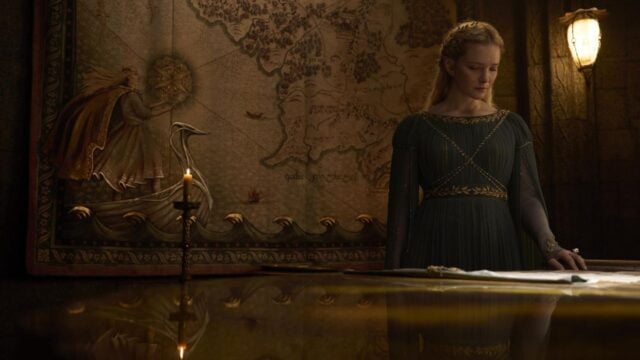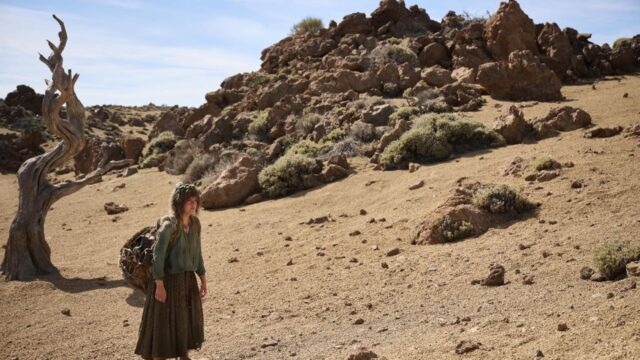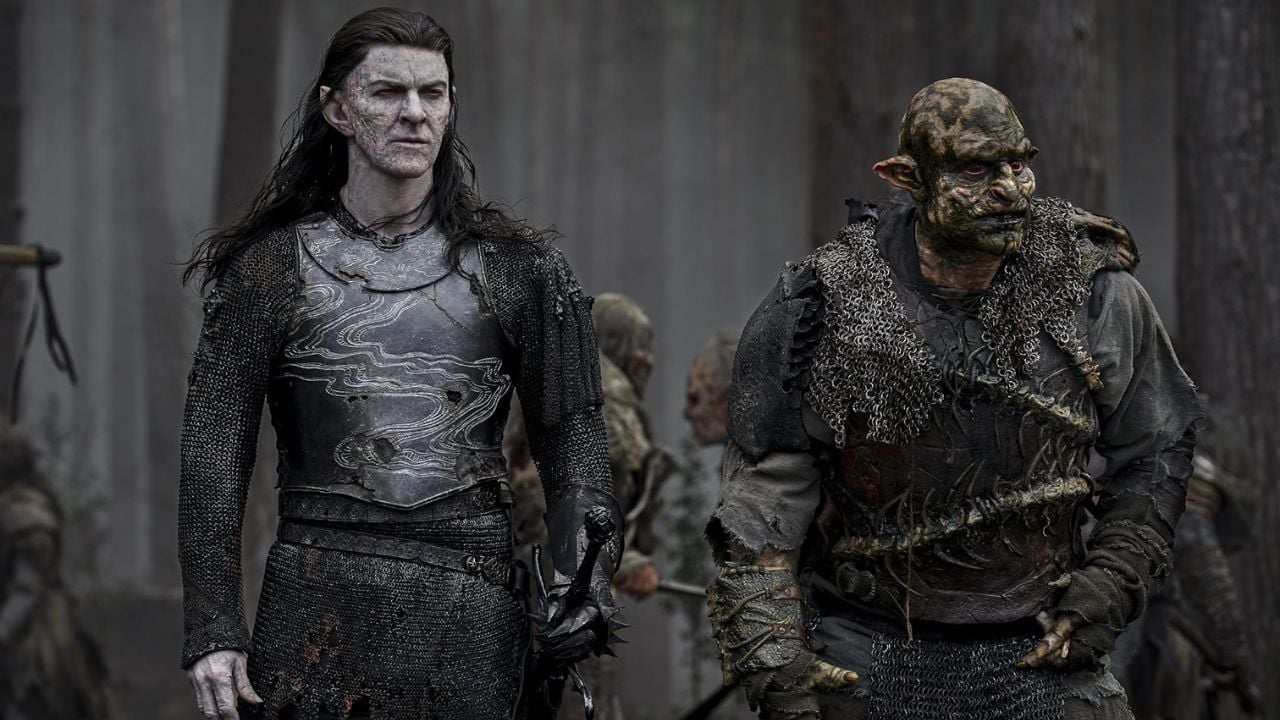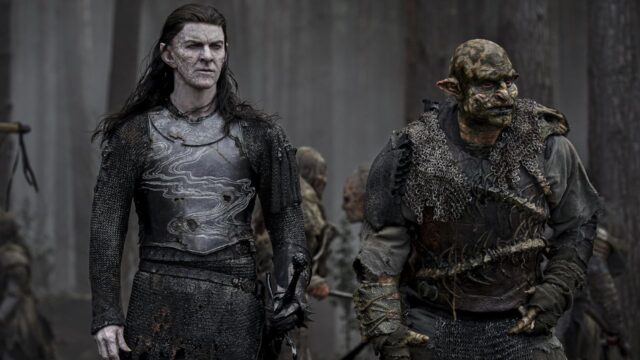The LotR prequel show, a hotbed of controversy among hardcore Tolkien fans, introduced several changes to Middle-earth lore. The Rings of Power Middle-earth map, a subject of heated debate, was not spared from these alterations.
The geography of Middle-earth in The Rings of Power differs significantly from the one that Frodo and his Fellowship traveled on in The Lord of the Rings. The Rings of Power’s Second Age landscape set more than 3000 years ago, provides some familiarity, but only to a limited extent.
Many kingdoms in The Rings of Power had fallen by the time The Lord of the Rings begins, and some countries in The Lord of the Rings are only twinkles in their founders’ eyes. Exploring the main areas on The Rings of Power map, on the other hand, reveals how Middle-earth evolved into the land that fans of LotR and The Hobbit are familiar with.
1. Valinor Lies To The West
Valinor, the Undying Lands, is located far west of Middle-earth, across the Sundering Seas. This blessed region is where the Elves migrate in The Lord of the Rings and where Frodo’s story finishes. Valinor could be reached by simply sailing west during The Rings of Power’s Second Age.
However, anyone who arrived uninvited (an accomplishment in and of itself) would not get far unless their presence was justified. Valinor made itself less accessible before The Lord of the Rings Third Age, with only a precise route known to a select few leading there.
Valinor, home to the powerful Valar, Maiar, and the Elves who remained behind, is a place of divine beauty and tranquility. Despite Morgoth’s destruction of the Two Trees of Valinor, even before The Rings of Power, its heavenly qualities continue to inspire and uplift all who dwell there.

2. Númenor Sits Between Valinor & Middle-earth
Númenor is located in a wide stretch of ocean between Valinor and Middle-earth. The Valar raised this star-shaped lump from the water as a gift to those who fought Morgoth in the First Age. Númenor’s people live longer and have built a formidable society with impressive architecture, culture, and skills.
The Númenoreans can sail eastward toward Middle-earth and establish a permanent presence in their forefathers’ homeland (whether they’ve started doing so in The Rings of Power remains to be discovered). Still, they are prohibited from traveling westward towards Valinor. For those wondering why the Númenoreans didn’t lend an assist in destroying the One Ring, the island was ravaged long before The Lord of the Rings began.
Aragorn and Boromir are both Númenorean descendants.
3. North-Western Middle-earth: Lindon & Eriador
To the west of Second Age Middle-earth lie two vast regions. Lindon, the de facto capital of the Elven race, is located on the coastline and is home to High King Gil-Galad, who spent the early Second Age constructing this wonderful realm. Círdan, the Shipwright, oversees the Grey Havens, one of the most populated places in The Rings of Power, bordering Eriador.
This is where any elf undertaking the journey to Valinor must leave, and it remains so even when Frodo sails there in The Lord of the Rings. During Frodo’s age, Númenor’s downfall and Gil-Galad’s death have reduced the importance and size of Lindon.
The territory of Eriador officially begins eastward, across the Blue Mountains. Eriador, a realm of verdant plains, grassland, and rolling hills, is less significant in The Rings of Power than in The Lord of the Rings.
In the centuries after Amazon’s history, Eriador is home to Elrond’s Rivendell and the Men’s realm of Arnor before a period of darkness brought on by the Witch-king of Anmar. Eriador is also where early hobbits settled to form the Shire, serving as the principal setting for The Fellowship of the Ring.
4. Elves In Eregion & Dwarves In Khazad-dûm
Eregion, The Rings of Power’s second major elven province, is found further east, near the Misty Mountains. At this period, Eregion was ruled by Celebrimbor, the legendary elven smith who forged the Rings of Power.
Eregion is another noble realm in the vein of Lindon and Rivendell, with one notable exception: it no longer exists when The Lord of the Rings takes place. Sauron’s troops destroy Eregion during the Second Age conflict between Elves and Enemies. Rivendell sprang from the ruins of Eregion.
The cavernous dwarf colony of Khazad-dûm, often known as the Mines of Moria, is located near Eregion in the Misty Mountains. Khazad-dûm, known for its significant role in the Fellowship of the Ring’s quest, is abandoned and ruined when Frodo and his companions pass through it.
In The Rings of Power, however, the society is prospering and buzzing at its peak. Khazad-dûm isn’t the only dwarven city in Second Age Middle-earth, with the hairy race inhabiting mountainous places throughout the country. Still, it is the only one of narrative significance.
5. The Enemy Lies North
The Rings of Power begin after Morgoth has been defeated but before Sauron has taken his master’s place as Middle-earth’s main antagonist. Because of The Lord of the Rings, most viewers identify evil with the South and Mordor, yet Sauron’s stronghold has yet to be built in Amazon’s chronology.
Instead of looking southward, watch for problems from the north. Morgoth’s strongholds, Utumno and Angband, were located among the Iron Mountains in Middle-earth’s frigid northern reaches.
Though these malevolent cold spots would have been conquered when The Rings of Power began, places like Forodwaith remain as icy wastelands, carrying the memory of evil.

6. Rhovanion (The Hobbit’s Setting) Is Very Different
Much like Eriador, the region of Rhovanion played a more significant role in the Third Age than the Second, but many of its famous locations still existed, albeit under different names. To the east of the Misty Mountains is the elvish land of Lórinand, which later becomes Galadriel’s realm of Lothlórien. The Rings of Power’s Galadriel has no time for such tasks.
Further east sits the huge forest that would ultimately be known as Mirkwood but isn’t called such in The Rings of Power since it isn’t murky yet. Finally, although The Hobbit’s mountain of Erebor remains as lonely as ever, the Dwarves have yet to establish their mining operation there.
According to J.R.R. Tolkien’s writings on Hobbits, early breeds like Harfoots moved west across the Misty Mountains before settling permanently in the Shire. Rhovanion is the setting for The Rings of Power’s Harfoot action, and it is vastly different from the Shire, where Frodo and the Harfoot’s other hobbit forebears live.
7. Gondor & Rohan Aren’t Yet Founded
South of Rhovanion, you’d normally discover the magnificently golden fields of Rohan, made famous by The Two Towers, before finally arriving at Middle-earth’s capital of Men, Gondor, which appears heavily in The Return of the King. When The Rings of Power begins, neither has an identifiable form.
The pre-Rohan territory is known as Calenardhon, and it bears little similarity to Théoden’s Scandinavian-tinged kingdom in The Lord of the Rings.
Gondor exists as a Men’s settlement during Tolkien’s Second Age, but it is far from the spectacular kingdom that Aragorn will inherit after Sauron’s destruction. Minas Tirith is not yet built, and no king reigns until Isildur moves to Middle-earth from Númenor and transforms Gondor into a powerful force.
8. Mordor Is The Southlands
Mordor is best known as Sauron’s gloomy stronghold in The Lord of the Rings, a barren, devastated region of ash and fire in which only nasty creatures flourish. Little is known of the place before Sauron laid his spiky helmet there. However, The Rings of Power’s marketing material mentions the Southlands, a Men-settled location.
However, as shown in The Rings of Power, the Southlands are the Middle-earth territory that would one day become Mordor.
Amazon’s The Rings of Power takes place immediately before Sauron established Mordor as his headquarters, and the Lord of the Rings prequel show shows viewers how the land looked before it became a dismal volcanic wasteland.
9. Why are The Maps In The Lord Of The Rings And The Rings Of Power Different?
When comparing The Rings of Power map to Lord of the Rings, there is a simple reason for the vast changes in named locations: time.
Because Lord of the Rings characters such as Galadriel and Elrond appear in The Rings of Power, it’s easy to overlook how many years have passed between LotR and the prequel series.
In context, if the elves above lived on Earth today at the stage in their lives depicted in Lord of the Rings, they’d be in Ancient Rome (or even earlier) at the age they were in The Rings of Power.
Several millennia pass between The Rings of Power and The Lord of the Rings. This is why several notable LotR locales, like Gondor, Rohan, the Shire, and even Mordor, are not included on The Rings of Power map.
Gondor may have been an ancient and established monarchy during The Lord of the Rings, but only from the perspective of humanity. To the elves, the founding of Minas Tirith was a comparatively recent development that occurred in the latter portion of their lives.
10. About The Lord of the Rings: The Rings of Power
The Lord of the Rings: The Rings of Power is an American TV series, based on the novel by J.R.R. Tolkien, developed by J.D. Payne and Patrick McKay for streaming on Amazon Prime.
Set 3,000 years before the events of The Hobbit and The Lord of the Rings, the show will be set in the Second Age of Middle-earth. Beginning with a time of peace, the series will follow the rise of the Dark Lord Sauron and the forging of the rings of power.
The cast includes Robert Aramayo, Owain Arthur, Nazanin Boniadi, Morfydd Clark, Ismael Cruz Cordova, Markella Kavenagh, Joseph Mawle, and Dylan Smith among many others.








No Comments on The Rings of Power Map and How is it Different From Lord Of The Rings